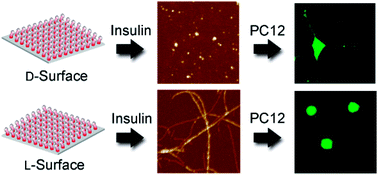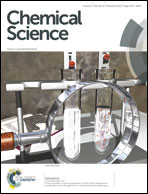Opposing enantiomers of tartaric acid anchored on a surface generate different insulin assemblies and hence contrasting cellular responses†
Abstract
Chirality plays a pivotal role in biomolecule recognition, which is one of the key aspects of cell responses to a biomaterial surface. Generally, the effects of the properties of a biomaterial surface on cellular responses are modulated by adsorbed proteins. Surface chemistry, such as charge and hydrophobicity, has a profound effect on protein adsorption. Nevertheless, chirality has been seldom considered in biomaterial surface chemistry. Herein, using the classical biogenic chiral molecules, D- and L-tartaric acid, assembled into monolayers as a model chiral surface, we reported for the first time that surface chirality modulated insulin assembly, including the dynamics of adsorption, kinetics of the conformational transition and fibril formation, on D- and L-surfaces and determined the cellular effect of insulin on neuronal PC12 cells. On the D-surface, insulin retained its bioactivity; however, on the L-surface, insulin formed amyloid fibrils with lost bioactivity. Previous reports have demonstrated that insulin can act as growth and neuronal differentiation factors. The chiral surfaces that were preassembled with insulin exhibited contrasting cellular behaviours in proliferation and differentiation. High proliferation and a high differentiation rate were observed for PC12 cells on the insulin-adsorbed D-surface, whereas neither proliferation nor differentiation were observed for PC12 cells on the insulin-adsorbed L-surface. Since protein surface adsorption is ubiquitous for tissue engineering and cell adhesion, our work provides new insights into engineering novel biomaterials by taking into account surface chirality. Surface chirality is important and may determine cell fate on a chiral surface.


 Please wait while we load your content...
Please wait while we load your content...